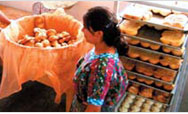Until recently, access to educational technology was nothing more than a dream for children of rural local communities in Guatemala’s highlands. USAID helped fund the installation of sixteen mini-technology centers called CETEBITOS which are equipped with 8-10 multimedia computers, a printer, Microsoft office software, as well as locally-developed multimedia software to help students develop reading and writing skills in their native languages of K’iche’, Sakapulteko, and Ixil.
Rural Guatemalan schools are not numerous. In addition, most teachers speak Spanish while first graders speak in one of twenty-one Mayan languages. Not sharing a common language halts the learning processes and causes children both frustration and humiliation, as well as possibly damaging their self-esteem. Before the USAID bilingual intercultural education programs, common wisdom was that technology had no place in this context of school.
USAID helped to introduce the technology model in rural primary schools of Guatemala which integrated the active participation of the entire community. Parent groups formed to equip the centers, obtain electricity and adequate security, and establish administrative and use policies. Teachers participated in extensive training to bring their new skills and knowledge to primary school students. Today, hundreds of children in the Quiché department are using computers to learn to read and write their first letters in their native Mayan languages.
|


